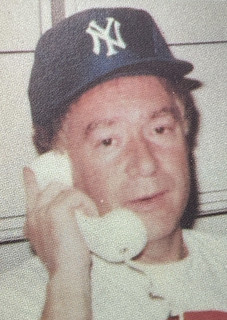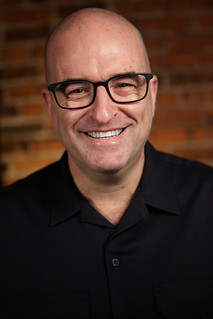
PREV ARTICLE
NEXT ARTICLE
FULL ISSUE
PREV FULL ISSUE
STAN KESSELMAN INTERVIEW, PART SEVENGreg Bennick's latest interview for the Newman Numismatic Portal is with New York dealer Stan Kesselman. Here's the seventh part, where Stan talks about Harry Bass, Ed Trompeter, Eddie Shapiro, Max Humbert, and uncut sheets of National Bank Notes. -Editor
GREG BENNICK: Please, absolutely. STANLEY KESSELMAN: Harry Bass married his childhood sweetheart from high school. I think they stayed married for like 40 years, a long time. Then they got divorced. Again, this is, you know, personal lives of successful rich people are not always good. And he suffered for that. He, for a while, would sleep all day. And then he'd be up all night. And he missed the TV programs. So, he'd have, at the time, VCRs going, maybe 15 VCRs at different stations to see what he missed. But he brought up his new fiancée to New York. And we're in the car with her. And he wants to buy her a present. So, we stopped in front of Tiffany's in New York City, 57th Street and Fifth Avenue. He tells his fiancée, go in there and buy whatever you want. She goes in the store. She's there five minutes, 10 minutes. And Harry's in the car. And Harry says, what do you think she's doing? I said, Harry, she's doing what you told her to do. Buy whatever she wants. So, Harry says, how much is she going to spend? I said, how should I know? You told her to go buy what she wants. And now Harry's getting nervous. He doesn't know what she's going to do. So we're in the car 20 minutes. She comes out of the store. He opens the door. She gets in. And Harry says, what did you do? She says, I didn't buy anything. I couldn't make up my mind what to do. And Harry says, Stanley, start driving. And he ended up, she was smarter than everybody. She ended up marrying him. And they got married. I imagine she spent $100,000 on a ring. He said, this girl's not for me. GREG BENNICK: Yeah, right. STANLEY KESSELMAN: So, she played her cards 100% correct by buying nothing. GREG BENNICK: That's amazing. That's amazing. So, is there anyone else from your memory that were players in the industry or friends of yours that you might have stories about? STANLEY KESSELMAN: I remember one about Ed Trompeter. Ed Trompeter was a big, big collector of proof gold coins. And he was in California. He had a wonderful business where he'd sell parts, metal parts, screws, and connectors that cost him $0.09. And he'd get a hell of a lot of money, more than $0.09. So he had Trompeter Electronics was his company. And we just bought from John Morrell his early fives. And Ed Trompeter was in Dallas. And John Morrell is in Dallas. And I'm in Dallas. And Michael Brownlee's in Dallas. So, we need money to pay John Morrell for his early fives. So why not sell them to Ed Trompeter? So, we went out for dinner. Michael, Ed Trompeter, and I. And Michael and Ed Trompeter are sitting on top of each other almost. They have their arms around each other. And Ed Trompeter is smoking a cigar. And he takes a few puffs. Takes that out of his mouth. And blows the smoke out. And the smoke goes into Michael's face. And Michael is talking and coughing. And his face is turning white. And he's got more smoke. He's coughing more. But Michael doesn't say anything. Like, get rid of that stupid cigar or whatever. Because he wanted Ed Trompeter to buy the coins. So, the more smoke Michael got, the more polite he was. And it ended up that Ed Trompeter took three coins back to California. And one of them was an 1819 half eagle in 65. John Moreau had beautiful coins. And the other two, I can't remember. But even then, it was hundreds of thousands of dollars. And Michael's happy. I'm happy. And then three days later, the coins come back in the mail. And the Goldbergs, who were Trompeter's advisor, said they were very much overpriced. And Trompeter sent them back. GREG BENNICK: Oh, wow. STANLEY KESSELMAN: So, Michael was very happy. He was really angry. For two reasons. First, we needed the money. And number two, of all the abuse he took with the smoke in his face. GREG BENNICK: He breathed all the smoke in his face. STANLEY KESSELMAN: Right. And I told him, don't worry about it. We took the coins up to New York to Paul Nugget at MTB. And he bought the three coins, one, two, three, and paid us more money. GREG BENNICK: Good. All right. Well, it worked out all right. With no smoke. STANLEY KESSELMAN: With no smoke. Right. And, you know, we eventually ended up selling the coins. A lot ended up, again, with Mack Pogue and his collection. GREG BENNICK: With the Pogue's, sure. STANLEY KESSELMAN: Yeah. And they did very well in their sale. GREG BENNICK: Great. Any other people come to mind other than Ed Trompeter? You knew Eddie Shapiro as well. Is that right? STANLEY KESSELMAN: Eddie Shapiro had a booth in the 47th Street New York Jewelry Exchange. And it was like a very small booth, as a jeweler would have. And he'd deal only in gold coins. And he was the richest person in the world, friendly to everybody. He used to work on the railroad. And he'd go from town to town. And when he stopped over, he'd go buy coins from people. But he had a lot of money for some reason for the day, paid for things instantly. And it was a wonderful personality. And he brought coins back from Europe. And when he bought coins from Europe, he went to the European banks. He didn't care what year it was, what date it was, what mint mark it was. And that's where he made a lot of money. And he was happy to sell them at wholesale to get his money back. And Tire Mountain International, Max Humbert, ran it. He did a lot of business over in banks. He had one person there permanently. And I remember Max offered me six 1921 twenties at one time. He had 1891 CC twenties. Beautiful coins that he sold for like $325 each. They were all pretty much uncirculated. But what he did, he took a lot of the uncirculated coins and marked them down to AU and lowered the price so he can sell more. Even though they were uncirculated, he undergraded them to get rid of them. And they were going $325 each. The 1891 CC had like a 5,000 mintage, but the coin was plentiful. It was almost like a hoard coin. And today, they probably sell $20,000, $30,000, $40,000 for nice ones, singly. People don't care about rarity and how rare the thing is. Totally rare. And then with Ed Trompeter, going back to him, I sold him his last proof gold coin to finish his whole proof set. GREG BENNICK: Really? STANLEY KESSELMAN: Yeah. It was an 1874 Eagle. Beautiful proof. I bought it. I can't remember where, but I know it's the only one I ever had. The coin is 20 struck. And I doubt there's more than five that exist. And it's somewhat unappreciated. Even one just sold for like $300,000 at auction in the last 12 months. But he complained that I charged him too much. And I wanted to get even for the smoke he blew in Michael's face. GREG BENNICK: Now, with Eddie Shapiro, did he deal with just coins or was there paper money as well that he dabbled in and explored? STANLEY KESSELMAN: Yeah, he had, I was in his bank vault, which he did business at. He never had a store. He just had people coming every hour to his bank vault to make appointments. And I guess the bank didn't care. And he paid some people to the vault some money. I was there once and he had currency sheets. 1929 currency sheets and they were stacked on top of each other. And I didn't know what they were. And he shows them to me. They have names, numbers, towns, and states. And I asked him what it was. He says he just bought this lot. The face value was $55,000. I said, "What'd you pay?" He said $55,000. But at that time, $55,000 to me was a fortune. And here he has this lying there doing nothing. And I liked him very much. They looked good. He had a $100 sheet, number one. $50 sheet, number one. Tons of $20 sheets, $10 sheets, $5 sheets. But I didn't know anything about them. So, he finally put them in a Lester Merkin sale, I think it was 1972. And it made multiples of $55. So, when I accumulated more money, I started getting interested in them, and I started to buy them. And I bought maybe 75 sheets. And I sold all 75 sheets to Ted Naftzger. I had a hoard of Reno, Nevada sheets. Maybe 30, 40 sheets from Reno, Nevada that I sold to Ted Naftzger as a group. He liked buying those kind of things. And I'll never forget this also with Ted Naftzger. I had $31,000 bills, singles, 1934. That were beautiful, uncirculated. And I sold it to Ted Naftzger for $30,000 face value. GREG BENNICK: Wow. STANLEY KESSELMAN: And he loved that. So, you know, he liked the big denomination. He probably gave them away. I don't know. They make very good Christmas gifts. Now an uncirculated $1,000 bill, I think is around $10,000. It was nice. GREG BENNICK: Wow. Very cool. STANLEY KESSELMAN: Yeah. So those were days, you know, that you bring back. I remember from William Donner, who was also an importer of gold coins. He had an 1870 CC half Eagle. Beautiful coin that I paid maybe $3,000 for a beautiful coin. You know, it's worth, I don't know, over a hundred thousand easy now because of the condition. It's just, you know, it's hard to compete in days like this where the coins are so expensive compared to where they were. But again, it's not, I contend it's not the coins that went up. It's the money to buy them with became so much more plentiful, so much more plentiful. Warren Buffett was on TV today with his annual meeting for five hours. And he remembers more of the mistakes he made, not of the profits he made. He said he learned more from his mistakes than when he did doing things right. You know, so I sort of take that philosophy myself, you know, you know, but it's, you know, it's a wonderful hobby. You meet wonderful people. The best thing is that people come from all over the country, different politics, different voice, different accents. And today, you know, that's important, you meet people from everywhere, from Midwest, from Texas, from California, from New Hampshire, wherever you are, because where people live, they have different points of view for sure. And we don't meet enough of Americans from different places. All we do is somewhat stay home and meet the same kind of people with the same views all the time, which is, you know, somewhat of a tragedy.
To watch the complete video, see:
To read the complete transcript, see:
To read the earlier E-Sylum article, see:
Wayne Homren, Editor The Numismatic Bibliomania Society is a non-profit organization promoting numismatic literature. See our web site at coinbooks.org. To submit items for publication in The E-Sylum, write to the Editor at this address: whomren@gmail.com To subscribe go to: https://my.binhost.com/lists/listinfo/esylum All Rights Reserved. NBS Home Page Contact the NBS webmaster 
|


